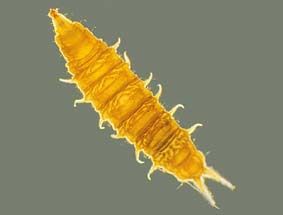Major Group: Insecta
Order: Diptera
Family: Athericidae
Subfamily: none |
Descriptive Features: head capsule incomplete (hemicephalic), often retracted into thorax, some sclerotization visible and extruded from thorax
mandibles usually with hooked apical tooth, lacking inner teeth
palps and antenna distinguishable
body slightly dorsoventrally flattened
metathoracic rods narrow throughout
abdomen 8-segmented
paired prolegs present on abdominal segments 1 - 7, prolegs "crochet-tipped"
single proleg on segment 8
lateral and dorsolateral tubercles on abdominal segments
posterior spiracles quite widely separated, not concealed on anal/pre-anal segment
anal segment frequently lobed
size: up to 10mm |

|
Athericidae |
|
|
|
Taxonomic Checklist: Species
Dasyomma abdominale Hardy
Dasyomma dissimile Hardy
Dasyomma flavum Hardy
Dasyomma hardyi Paramonov
Dasyomma hydrophilum Paramonov
Dasyomma infernale Paramonov
Dasyomma maculipenne Hardy
Dasyomma mcalpinei Paramonov
Dasyomma norrisi Paramonov
Dasyomma tasmanicum Paramonov
Dasyomma tonnoiri Paramonov
Suraginella macalpinei Stuckenberg |
|
Distribution: Australia wide except SA, WA?
Sensitivity Rating: SIGNAL grade 8
Functional Feeding Group: predators |

|
Snowy Creek near Mitta Mitta, Vic |
|
|
Ecology: Instream habitat: Athericid larvae are found in the beds of fast flowing streams and rivers. In northern Australia, each individual species has been recorded as occupying a particular section of the river profile.
Feeding ecology: Larvae are predators, feeding on a range of smaller invertebrates. Some adults are thought to feed on animal blood but not human blood.
Habit:
Life history: In the Northern hemisphere, final instar larvae leave the water to pupate. Females are thought to lay their eggs on overhanging riparian vegetation so that newly hatched larvae can drop straight into the water.
|
| |
Information Sources: Hawking & Smith 1997, Colless & McAlpline 1991, Elliot 2005, Williams 1980, Stuckenberg 2000
Key to Genera: none
Key to Species: none |
|
|
|